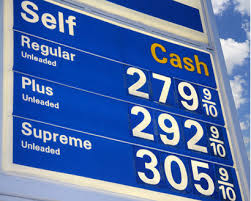As I was driving into Philadelphia today, I noticed something that I never “paid” attention to before, despite making the same trip well over a hundred times.
I was taking Lancaster Avenue from the Main Line to West Philadelphia, and the change in the economic status along the way is quite obvious, and it’s always been pretty apparent to me. The Main Line is one of the wealthiest parts of the country, while West Philadelphia is among the poorest. The difference can be seen in the housing, the stores, and the general environment.
The change happens pretty quickly as well. There is a street that separates the city from the suburbs, appropriately named City Avenue. Once you cross this street, you start to notice the changes within a couple of blocks.
What I noticed for the first time today though was the difference in gas prices as I drove into the city. If someone had asked me beforehand where I thought gas prices would be higher, on the Main Line, or in West Philadelphia, I would have quickly answered the Main Line.
However, that was not the case. I had filled up my tank before leaving, paying 2.57 per gallon. While driving through West Philadelphia, I saw four gas stations within a half mile of each other with prices ranging from 2.71 to 2.79 per gallon.
That doesn’t make sense to me, and it doesn’t seem fair either.
I wanted to see if there was anything to this, so I searched the web and came across a couple of interesting articles.
The first article I found, by sheer coincidence, also wrote about this issue in the city of Philadelphia. While this article examined gas prices while driving up Broad Street from North Philadelphia to the northern suburbs, author Dave Warner noticed the same phenomenon, that gas prices were significantly higher in North Philadelphia, one of the highest poverty sections of the city, and were lower in the suburbs.
Warner wondered how the people in one of the city’s poorest neighborhoods end up paying more than the folks with Beemers in the driveway further north. That question stumped Ross DiBono, executive director of the Pennsylvania Gasoline Retailers Association. Oil companies set the wholesale prices, and typically the station operators keep only 5 or 6 cents a gallon. “In most cases, the oil companies charge whatever they think they can get away with,” he said.
While the first article was anecdotal in its look at gas prices, the second article I came across was a formal research study by Caitlin Knowles Myers Grace Close, Laurice Fox, John William Meyer, and Madeline Niemi from Middlebury College.
The authors found that gasoline prices did not vary greatly with neighborhood racial composition, but that prices were higher in poor neighborhoods. For a 10 percentage point increase in the percent of families with incomes below the poverty line relative to families with incomes between 1 and 2 times the poverty line, retail gasoline prices were estimated to increase by an average of 0.70 percent. This differential was reduced to 0.22 percent once controls were added for costs, competition, and demand. The authors felt that the remaining, small, price differential for poor neighborhoods was likely the result of traditional price discrimination in response to less competition and/or more inelastic demand in these locations.
Based on the gas prices that were in effect when this second article was written, the .70 percent premium amounted to about 28 cents for a 15 gallon tank, or about two cents per gallon more.
The authors concluded that there is a small poverty premium that may represent a noteworthy burden for the very poor living in very poor neighborhoods.
So while there is empirical evidence to support what I observed, the research does not seem to indicate that it is a major difference.
However, I observed a much greater difference than just two cents per gallon, one gas station was 22 cents higher in West Philadelphia than what I paid for gas in the suburbs. That’s over $3 for a 15-gallon tank. Assuming that you get gas weekly, that’s more than a $150 annual premium that people in the poorest neighborhoods are paying for gas.
That’s enough to buy groceries for a week for a family of four; I would consider that significant, particularly for those living below the poverty line.
So why is this?
Is it just a matter of of the oil companies doing whatever they want, as the first article suggests?
Or is it a matter of less competition and/or more inelastic demand, as suggested by the researchers from Middlebury College?
My guess is that it is a combination of all of these factors, but no matter what the reason, it is just wrong.
I would gladly pay 15 cents extra per gallon of gas if it meant that people in low income neighborhoods were paying less.
Maybe it’s time for a socially responsible chain of gas stations…

